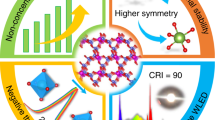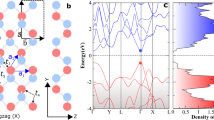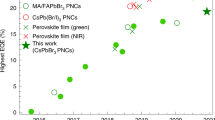Abstract
Phosphor-converted white light-emitting diodes (pc-WLEDs) are efficient light sources used in lighting, high-tech displays, and electronic devices. One of the most significant challenges of pc-WLEDs is the thermal quenching, in which the phosphor suffers from emission loss with increasing temperature during high-power LED operation. Here, we report a blue-emitting Na3–2xSc2(PO4)3:xEu2+ phosphor (λem = 453 nm) that does not exhibit thermal quenching even up to 200 °C. This phenomenon of zero thermal quenching originates from the ability of the phosphor to compensate the emission losses and therefore sustain the luminescence with increasing temperature. The findings are explained by polymorphic modification and possible energy transfer from electron–hole pairs at the thermally activated defect levels to the Eu2+ 5d-band with increasing temperature. Our results could initiate the exploration of phosphors with zero thermal quenching for high-power LED applications.
This is a preview of subscription content, access via your institution
Access options
Access Nature and 54 other Nature Portfolio journals
Get Nature+, our best-value online-access subscription
$29.99 / 30 days
cancel any time
Subscribe to this journal
Receive 12 print issues and online access
$259.00 per year
only $21.58 per issue
Buy this article
- Purchase on Springer Link
- Instant access to full article PDF
Prices may be subject to local taxes which are calculated during checkout





Similar content being viewed by others
References
Reineke, S. Complementary LED technologies. Nat. Mater. 14, 459–462 (2015).
Pust, P, Schmidt, P. J. & Schnick, W. A revolution in lighting. Nat. Mater. 14, 454–458 (2015).
Xia, Z. & Liu, R.-S. Tunable blue-green color emission and energy transfer of Ca2Al3O6F:Ce3+, Tb3+ phosphors for near-UV white LEDs. J. Phys. Chem. C 116, 15604–15609 (2012).
Lin, C. C. & Liu, R.-S. Advances in phosphors for light-emitting diodes. J. Phys. Chem. Lett. 2, 1268–1277 (2011).
Daicho, H. et al. A novel phosphor for glareless white light-emitting diodes. Nat. Commun. 3, 1132 (2012).
Zhu, H. et al. Highly efficient non-rare-earth red emitting phosphor for warm white light-emitting diodes. Nat. Commun. 5, 4312 (2014).
Muñoz, G. H., de la Cruz, C. L., Muñoz, A. F. & Rubio, J. O. High-temperature luminescence properties of Eu2+-activated alkali halide phosphor materials. J. Mater. Sci. Lett. 7, 1310–1312 (1988).
Blasse, G. & Grabmaier, B. Luminescent Materials (Springer, 1994).
Dorenbos, P. Thermal quenching of Eu2+ 5d–4f luminescence in inorganic compounds. J. Phys. Condens. Matter 17, 8103–8111 (2005).
Blasse, G. Thermal quenching of characteristic fluorescence. J. Chem. Phys. 51, 3529–3530 (1969).
Takeda, T., Hirosaki, N., Funahshi, S. & Xie, R.-J. Narrow-band green-emitting phosphor Ba2LiSi7AlN12:Eu2+ with high thermal stability discovered by a single particle diagnosis approach. Chem. Mater. 27, 5892–5898 (2015).
Xie, R.-J. & Hirosaki, N. Silicon-based oxynitride and nitride phosphors for white LEDs—a review. Sci. Tech. Adv. Mater. 8, 588–600 (2007).
Chen, L., Lin, C.-C., Yeh, C.-W. & Liu, R.-S. Light converting inorganic phosphors for white light-emitting diodes. Materials 3, 2172–2195 (2010).
Bachmann, V. et al. Color point tuning for (Sr, Ca, Ba)Si2O2N2:Eu2+ for white light LEDs. Chem. Mater. 21, 316–325 (2009).
Im, W. B. et al. Efficient and color-tunable oxyfluoride solid solution phosphors for solid-state white lighting. Adv. Mater. 23, 2300–2305 (2011).
Im, W. B. et al. Sr2.975−xBaxCe0.025AlO4F: a highly efficient green-emitting oxyfluoride phosphor for solid state white lighting. Chem. Mater. 22, 2842–2849 (2010).
Zhuang, J. et al. The improvement of moisture resistance and thermal stability of Ca3SiO4Cl2:Eu2+ phosphor coated with SiO2 . Appl. Surf. Sci. 257, 4350–4353 (2011).
Lee, H. S. & Yoo, J. W. Yellow phosphors coated with TiO2 for the enhancement of photoluminescence and thermal stability. Appl. Surf. Sci. 257, 8355–8359 (2011).
Nakanishi, T. & Tanabe, S. Preparation and luminescent properties of Eu2+-activated glass ceramic phosphor precipitated with β-Ca2SiO4 and Ca3Si2O7 . Phys. Status Solidi A 206, 919–922 (2009).
Bykov, A. B. et al. Superionic conductors Li3M2(PO4)3 (M = Fe, Sc, Cr): Synthesis, structure and electrophysical properties. Solid State Ion. 38, 31–52 (1990).
de la Rochère, M. et al. NASICON type materials—Na3M2(PO4)3 (M = Sc, Cr, Fe): Na+-Na+ correlations and phase transitions. Solid State Ion. 9–10, 825–828 (1983).
Masui, T., Koyabu, K., Tamura, S. & Imanaka, N. Synthesis of a new NASICON-type blue luminescent material. J. Alloys Compd. 418, 73–76 (2006).
Saradhi, M., Pralong, V., Varadaraju, U. & Raveau, B. Facile chemical insertion of lithium in Eu0.33Zr2(PO4)3—an elegant approach for tuning the photoluminescence properties. Chem. Mater. 21, 1793–1795 (2009).
Delbecq, C. J., Marshall, S. A. & Susman, S. Evidence for a structural phase change in the fast-ion conductor Na3Sc2P3O12 . Solid State Ion. 1, 145–149 (1980).
Mundy, J., Shenoy, G. & Vashishta, P. Fast ion transport in solids: electrodes, and electrolytes Proc. Int. Conf. Fast Ion Transport in Solids, Electrodes, and Electrolytes (Elsevier North Holland, 1979).
Wickleder, M. S. Inorganic lanthanide compounds with complex anions. Chem. Rev. 102, 2011–2088 (2002).
Sorokin, N. I. Na+-ion conductivity of double phosphate Na3Sc2(PO4)3 in the region of the β–γ transition. Phys. Solid State 56, 678–681 (2014).
Collin, G., Comes, R., Boilot, J. & Colomban, P. Disorder of tetrahedra in Nasicon-type structure—I.: Na3Sc2(PO4)3: structures and ion–ion correlations. J. Phys. Chem. Solids 47, 843–854 (1986).
Winand, J. M., Rulmont, A. & Tarte, P. Ionic conductivity of the Na1+xMxIIIZr2−x(PO4)3 systems (M = Al, Ga, Cr, Fe, Sc, In, Y, Yb). J. Mater. Sci. 25, 4008–4013 (1990).
Keen, D. A. Disordering phenomena in superionic conductors. J. Phys. Condens. Matter 14, R819–R857 (2002).
Mazza, D. Modeling ionic conductivity in nasicon structures. J. Solid State Chem. 156, 154–160 (2001).
Pan, Z., Lu, Y.-Y. & Liu, F. Sunlight-activated long-persistent luminescence in the near-infrared from Cr3+-doped zinc gallogermanates. Nat. Mater. 11, 58–63 (2012).
Garlick, G. & Gibson, A. The electron trap mechanism of luminescence in sulphide and silicate phosphors. Proc. Phys. Soc. 60, 574–590 (1948).
Van den Eeckhout, K., Smet, P. F. & Poelman, D. Persistent luminescence in Eu2+-doped compounds: a review. Materials 3, 2536–2566 (2010).
Larson, A. C. & Von Dreele, R. B. General Structure Analysis System (GSAS) Los Alamos National Laboratory Report LAUR 86–748 (The Regents of the University of California, 1994).
Momma, K. & Izumi, F. VESTA: a three-dimensional visualization system for electronic and structural analysis. J. Appl. Crystallogr. 41, 653–658 (2008).
Blöchl, P. E. Projector augmented-wave method. Phys. Rev. B 50, 17953–17979 (1994).
Perdew, J. P., Burke, K. & Ernzerhof, M. Generalized gradient approximation made simple. Phys. Rev. Lett. 77, 3865–3868 (1996).
Kresse, G. & Furthmüller, J. Efficient iterative schemes for ab initio total-energy calculations using a plane-wave basis set. Phys. Rev. B 54, 11169–11186 (1996).
Monkhorst, H. J. & Pack, J. D. Special points for Brillouin-zone integrations. Phys. Rev. B 13, 5188–5192 (1976).
Acknowledgements
This research is supported by the Strategic Key-Material Development and the Materials and Components Research and Development bodies, funded by the Ministry of Knowledge Economy (Project No. 10044203, MKE, Korea). This work was also financially supported by the Basic Science Research Program through the National Research Foundation of Korea (NRF) funded by Ministry of Science, ICT & Future Planning (NRF-2014R1A1A1002909 and 2016R1E1A2020571). This research was supported by a Global PhD Fellowship Program through the NRF funded by the Ministry of Education (NRF-2015H1A2A1033990).
Author information
Authors and Affiliations
Contributions
W.B.I. and Y.H.K. designed the concept and experiments. Y.H.K., B.Y.K. and E.K. performed all the experiments. W.B.I., P.A. and Y.H.K. analysed and contributed to the technical discussions of results, and wrote the manuscript. S.U. performed combined Rietveld refinement of X-ray and neutron powder diffraction results. S.-H.M. and J.-S.L. carried out high-temperature impedance analysis and interpreted the results. D.L. performed the DFT calculations. K.H.K., J.Y.H. and Y.H.K. measured and analysed the high-temperature decay curve results.
Corresponding author
Ethics declarations
Competing interests
The authors declare no competing financial interests.
Supplementary information
Supplementary Information
Supplementary Information (PDF 1151 kb)
Rights and permissions
About this article
Cite this article
Kim, Y., Arunkumar, P., Kim, B. et al. A zero-thermal-quenching phosphor. Nature Mater 16, 543–550 (2017). https://doi.org/10.1038/nmat4843
Received:
Accepted:
Published:
Issue Date:
DOI: https://doi.org/10.1038/nmat4843
This article is cited by
-
Laser-driven broadband near-infrared light source with watt-level output
Nature Photonics (2024)
-
Dynamic multicolor emissions of multimodal phosphors by Mn2+ trace doping in self-activated CaGa4O7
Nature Communications (2024)
-
Exploring a new Sm3+-activated tungstate phosphor with thermally stable photoluminescence
Journal of the Iranian Chemical Society (2023)
-
Lanthanide-based ratiometric luminescence nanothermometry
Nano Research (2023)
-
High-temperature solid-phase synthesis of eulyite-type Ba3Yb(PO4)3 as a single host for narrow-band Tb3+ green emission
Journal of Materials Science: Materials in Electronics (2023)



